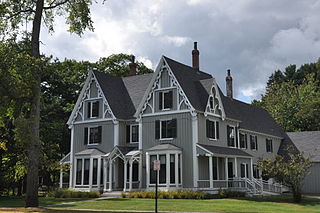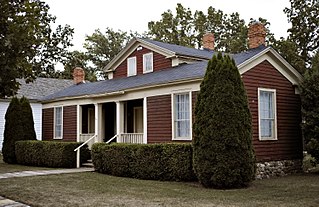
The Charles Payne House is an historic site at 25 Brown Street in Pawtucket, Rhode Island. The house was built in 1855–56 by Charles Payne and later expanded with the addition of two ells and a porch. The 1 1⁄2-story Gothic-Italianate vernacular cottage is architecturally significant as a 19th-century vernacular cottage in a picturesque setting. Though the round-head picket fence and entry gates were later removed, the property retains a large shaded garden on with ample street frontage. The Charles Payne House was added to the National Register of Historic Places in 1983.

Cannondale Historic District is a historic district in the Cannondale section in the north-central area of the town of Wilton, Connecticut. The district includes 58 contributing buildings, one other contributing structure, one contributing site, and 3 contributing objects, over a 202 acres (82 ha). About half of the buildings are along Danbury Road and most of the rest are close to the Cannondale train station.

The William B. Sherman Farm is a historic farmhouse located at 1072 State Road in North Adams, Massachusetts. Built in the 1820s, it is one the city's few surviving 19th-century houses, with relatively few alterations since its elaborate Italianate porch in the 1870s. It was listed on the National Register of Historic Places in 1985.

The Gifford–Walker Farm, also known as the Alice Walker Farm, is located on North Bergen Road in North Bergen, New York, United States. Its farmhouse is a two-story Carpenter Gothic style structure built in 1870.

The William H. Rose House is located on Tomkins Avenue in Stony Point, New York, United States. It is an ornate Carpenter Gothic-style house from the mid-19th century, with similar outbuildings, built for a wealthy local businessman.

Ardoyne Plantation House is located on Highway 311 in Schriever, Louisiana, just northwest of Houma, Louisiana. It was built 1894 and added to the National Register of Historic Places on November 1, 1982.

The George Rymph House is a historic house located on Albany Post Road in Hyde Park, New York, United States. It is a stone house built during the 1760s by a recent German immigrant. In 1993 it was listed on the National Register of Historic Places.

The Henry Boody House also known as the Boody-Johnson House, is an historic house at 256 Maine Street in Brunswick, Maine, United States. Built in 1849, it is an important early example of Gothic Revival Architecture, whose design was published by Andrew Jackson Downing in 1850 and received wide notice. It was listed on the National Register of Historic Places on 1975.

The John and Rosetta Lee House is a private residential structure located at 823 Calhoun Street in the city of Lapeer in Lapeer County, Michigan. It was added to the National Register of Historic Places on July 26, 1985.

The Colin McCormick House is a historical house in Owosso, Michigan, designed by Edger Ingersoll, and is notable for its size. It has had only 4 owners in its more than 120-year history. The last member of the McCormick family died in the house at 107 years of age. Edger Ingersoll incorporated features like the slate roof, crocheted roof ridging, hipped roof, scalloped trim, and more. It lies at 220 E. Exchange. The house was added to the National Register of Historic Places in 1980.

The Joshua Pettegrove House is a historic house on St. Croix Drive in the Red Beach area of Calais, Maine. Built about 1854, it is one of a number of high-quality Gothic Revival houses in the region, and is one of the few in the state set in a landscape adhering to principles laid down by Gothic Revival proponent Andrew Jackson Downing. The house was listed on the National Register of Historic Places in 1994.

The Ebenezer Gould House is a historic house in the Corunna Historical Village in Corunna, Michigan. The house was built in 1840 and added to the National Register of Historic Places on November 4, 1980.

The Ezra E. and Florence (Holmes) Beardsley House is a private house located at 1063 Holmes Road in Bronson Township, Michigan. It was listed on the National Register of Historic Places in 2015.

The East Michigan Avenue Historic District is a residential historic district located at 300-321 East Michigan Avenue, 99-103 Maple Street, and 217, 300 and 302 East Henry in Saline, Michigan. It was listed on the National Register of Historic Places in 1985.

The Bell-Spalding House, also known as the Tuomy House, is a single-family home located at 2117 Washtenaw Avenue in Ann Arbor, Michigan. It was listed on the National Register of Historic Places in 1990.

The John N. Ingersoll House is a single-family home located at 570 West Corunna Avenue in Corunna, Michigan. It was listed on the National Register of Historic Places in 1980.

The Christian-Ellis House is a single-family home located at 600 North Water Street in Owosso, Michigan. It was listed on the National Register of Historic Places in 1980.

The Michigan Avenue-Genessee Street Historic Residential District is a primarily residential historic district, located along Michigan Ave between Clinton Street and the railroad tracks, and along Genesee Street from Michigan Avenue to Shiawassee Street in Owosso, Michigan. It was listed on the National Register of Historic Places in 1980.

The Benjamin Williams House is a single-family home located at 520 North Adams Street in Owosso, Michigan. It was listed on the National Register of Historic Places in 1980.

The Roethke Houses are two side-by-side single family homes located at 1759 and 1805 Gratiot Avenue in Saginaw, Michigan. THey were listed on the National Register of Historic Places in 2001.





























